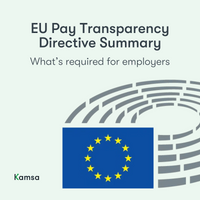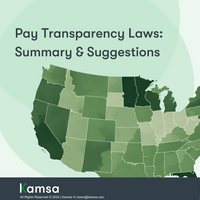
EU Pay Transparency Directive Summary
EU Pay Transparency Directive is a legislative act that requires compliance from EU countries by June 7, 2026.
Below is a summary of what’s required for employers according to the EU Pay Transparency Directive:
Equal work and work of equal value
- Requires employers to have pay structures to ensure equal pay for equal work or work of equal value
- Employers must establish gender-neutral job evaluation & classification systems (i.e., via use of analytical tools or methodologies) to assess and compare the value of work
Pay transparency prior to employment
- Applicants have the right to receive (from prospective employers) information about the initial pay or its range based on objective, gender-neutral criteria for the position.
- An employer shall not ask applicants about their pay history
Transparency of pay setting & pay progression policy
- Employers shall make the criteria used to determine workers’ pay, pay levels, and pay progression accessible to their employees
- Member states may exempt companies with less than 50 employees
Right to information
Workers have the right to request and receive their pay level, average pay level, broken down by sex, for categories of workers performing the same work as them or of equal value to theirs.
- Employers must inform workers of their right to the above information, annually
- Employers must provide the above information within 2 months of the request
Reporting on pay gap between female & male workers
Employers are required to provide the following information concerning their organization:
- Gender pay gap
- Gender pay gap in complementary or variable components
- Median gender pay gap
- Median gender pay gap in complementary or variable components
- Proportion of female & male workers receiving complementary or variable components
- Proportion of female & male workers in each quartile of pay band
- Gender pay gap between workers by categories of workers broken down by ordinary basic wage or salary and complementary or variable components
Joint pay assessment
When there’s at least a 5% difference in average pay level between male and female workers in any category of workers, and the employers within Member States has not justified the difference on the basis of objective, gender-neutral criteria, they need to take appropriate measures to conduct a joint pay assessment with worker representatives to ensure conditions are met within 6 months of the date of submission of the pay reporting.
The joint pay assessment should identify, remedy, and prevent unjustified pay differences between female and male workers and shall include the following:
- An analysis on the proportion of female and male workers in each category of workers;
- Information on average female and male workers’ pay levels and complementary or variable components for each category of workers;
- Difference in average pay levels between female and male workers in each category of workers;
- Reasons for such differences in average pay levels, on the basis of objective, gender-neutral criteria, if any;
- Proportion of female and male workers who benefited from any improvement in pay following their return from leave of absence (e.g., maternity, paternity, parental or carers’ leave), if such improvement occurred in the relevant category of workers during the period in which the leave was taken;
- Measures to address differences in pay if they are not justified on the basis of objective, gender-neutral criteria; and
- An evaluation of the effectiveness of measures from previous joint pay assessments.
The deadline on when companies need to comply depends on employee size:
- 250 workers - must provide the information above relating to the previous calendar year, by 7 June 2027 and every year thereafter
- 150 to 249 workers - must provide the information above relating to the previous calendar year, by 7 June 2027 and every three years thereafter
- 100 to 149 workers - must provide the information above relating to the previous calendar year, by 7 June 2031 and every three years thereafter
- < 100 employees - Member States may require employers to provide information on pay
About Kamsa
Kamsa helps companies comply with the EU Pay Transparency Directive by leveraging our proprietary market data and machine learning technology to quickly conduct job leveling and establish compensation structures and pay ranges for all jobs.
Don’t wait to start your pay transparency journey until the last minute. Email [email protected] for more information on how Kamsa can get you proactively compliant with the EU Pay Transparency Directive.


